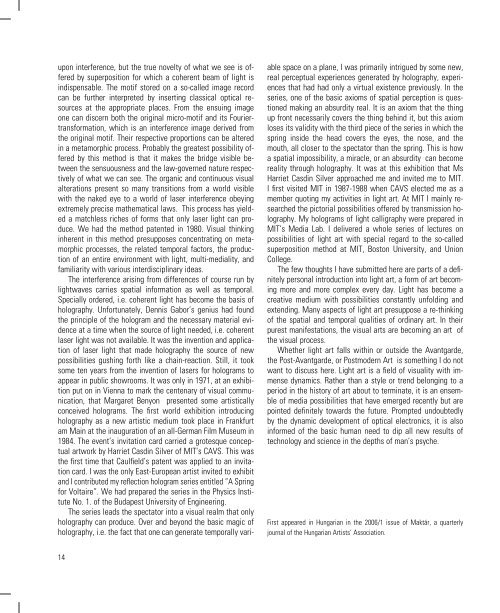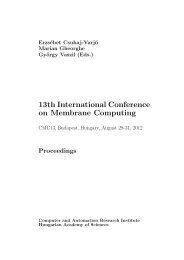Time on the Tilt
Time on the Tilt
Time on the Tilt
You also want an ePaper? Increase the reach of your titles
YUMPU automatically turns print PDFs into web optimized ePapers that Google loves.
up<strong>on</strong> interference, but <strong>the</strong> true novelty of what we see is offered<br />
by superpositi<strong>on</strong> for which a coherent beam of light is<br />
indispensable. The motif stored <strong>on</strong> a so-called image record<br />
can be fur<strong>the</strong>r interpreted by inserting classical optical resources<br />
at <strong>the</strong> appropriate places. From <strong>the</strong> ensuing image<br />
<strong>on</strong>e can discern both <strong>the</strong> original micro-motif and its Fouriertransformati<strong>on</strong>,<br />
which is an interference image derived from<br />
<strong>the</strong> original motif. Their respective proporti<strong>on</strong>s can be altered<br />
in a metamorphic process. Probably <strong>the</strong> greatest possibility offered<br />
by this method is that it makes <strong>the</strong> bridge visible between<br />
<strong>the</strong> sensuousness and <strong>the</strong> law-governed nature respectively<br />
of what we can see. The organic and c<strong>on</strong>tinuous visual<br />
alterati<strong>on</strong>s present so many transiti<strong>on</strong>s from a world visible<br />
with <strong>the</strong> naked eye to a world of laser interference obeying<br />
extremely precise ma<strong>the</strong>matical laws. This process has yielded<br />
a matchless riches of forms that <strong>on</strong>ly laser light can produce.<br />
We had <strong>the</strong> method patented in 1980. Visual thinking<br />
inherent in this method presupposes c<strong>on</strong>centrating <strong>on</strong> metamorphic<br />
processes, <strong>the</strong> related temporal factors, <strong>the</strong> producti<strong>on</strong><br />
of an entire envir<strong>on</strong>ment with light, multi-mediality, and<br />
familiarity with various interdisciplinary ideas.<br />
The interference arising from differences of course run by<br />
lightwaves carries spatial informati<strong>on</strong> as well as temporal.<br />
Specially ordered, i.e. coherent light has become <strong>the</strong> basis of<br />
holography. Unfortunately, Dennis Gabor’s genius had found<br />
<strong>the</strong> principle of <strong>the</strong> hologram and <strong>the</strong> necessary material evidence<br />
at a time when <strong>the</strong> source of light needed, i.e. coherent<br />
laser light was not available. It was <strong>the</strong> inventi<strong>on</strong> and applicati<strong>on</strong><br />
of laser light that made holography <strong>the</strong> source of new<br />
possibilities gushing forth like a chain-reacti<strong>on</strong>. Still, it took<br />
some ten years from <strong>the</strong> inventi<strong>on</strong> of lasers for holograms to<br />
appear in public showrooms. It was <strong>on</strong>ly in 1971, at an exhibiti<strong>on</strong><br />
put <strong>on</strong> in Vienna to mark <strong>the</strong> centenary of visual communicati<strong>on</strong>,<br />
that Margaret Beny<strong>on</strong> presented some artistically<br />
c<strong>on</strong>ceived holograms. The first world exhibiti<strong>on</strong> introducing<br />
holography as a new artistic medium took place in Frankfurt<br />
am Main at <strong>the</strong> inaugurati<strong>on</strong> of an all-German Film Museum in<br />
1984. The event’s invitati<strong>on</strong> card carried a grotesque c<strong>on</strong>ceptual<br />
artwork by Harriet Casdin Silver of MIT’s CAVS. This was<br />
<strong>the</strong> first time that Caulfield’s patent was applied to an invitati<strong>on</strong><br />
card. I was <strong>the</strong> <strong>on</strong>ly East-European artist invited to exhibit<br />
and I c<strong>on</strong>tributed my reflecti<strong>on</strong> hologram series entitled “A Spring<br />
for Voltaire”. We had prepared <strong>the</strong> series in <strong>the</strong> Physics Institute<br />
No. 1. of <strong>the</strong> Budapest University of Engineering.<br />
The series leads <strong>the</strong> spectator into a visual realm that <strong>on</strong>ly<br />
holography can produce. Over and bey<strong>on</strong>d <strong>the</strong> basic magic of<br />
holography, i.e. <strong>the</strong> fact that <strong>on</strong>e can generate temporally variable<br />
space <strong>on</strong> a plane, I was primarily intrigued by some new,<br />
real perceptual experiences generated by holography, experiences<br />
that had had <strong>on</strong>ly a virtual existence previously. In <strong>the</strong><br />
series, <strong>on</strong>e of <strong>the</strong> basic axioms of spatial percepti<strong>on</strong> is questi<strong>on</strong>ed<br />
making an absurdity real. It is an axiom that <strong>the</strong> thing<br />
up fr<strong>on</strong>t necessarily covers <strong>the</strong> thing behind it, but this axiom<br />
loses its validity with <strong>the</strong> third piece of <strong>the</strong> series in which <strong>the</strong><br />
spring inside <strong>the</strong> head covers <strong>the</strong> eyes, <strong>the</strong> nose, and <strong>the</strong><br />
mouth, all closer to <strong>the</strong> spectator than <strong>the</strong> spring. This is how<br />
a spatial impossibility, a miracle, or an absurdity can become<br />
reality through holography. It was at this exhibiti<strong>on</strong> that Ms<br />
Harriet Casdin Silver approached me and invited me to MIT.<br />
I first visited MIT in 1987-1988 when CAVS elected me as a<br />
member quoting my activities in light art. At MIT I mainly researched<br />
<strong>the</strong> pictorial possibilities offered by transmissi<strong>on</strong> holography.<br />
My holograms of light calligraphy were prepared in<br />
MIT’s Media Lab. I delivered a whole series of lectures <strong>on</strong><br />
possibilities of light art with special regard to <strong>the</strong> so-called<br />
superpositi<strong>on</strong> method at MIT, Bost<strong>on</strong> University, and Uni<strong>on</strong><br />
College.<br />
The few thoughts I have submitted here are parts of a definitely<br />
pers<strong>on</strong>al introducti<strong>on</strong> into light art, a form of art becoming<br />
more and more complex every day. Light has become a<br />
creative medium with possibilities c<strong>on</strong>stantly unfolding and<br />
extending. Many aspects of light art presuppose a re-thinking<br />
of <strong>the</strong> spatial and temporal qualities of ordinary art. In <strong>the</strong>ir<br />
purest manifestati<strong>on</strong>s, <strong>the</strong> visual arts are becoming an art of<br />
<strong>the</strong> visual process.<br />
Whe<strong>the</strong>r light art falls within or outside <strong>the</strong> Avantgarde,<br />
<strong>the</strong> Post-Avantgarde, or Postmodern Art is something I do not<br />
want to discuss here. Light art is a field of visuality with immense<br />
dynamics. Ra<strong>the</strong>r than a style or trend bel<strong>on</strong>ging to a<br />
period in <strong>the</strong> history of art about to terminate, it is an ensemble<br />
of media possibilities that have emerged recently but are<br />
pointed definitely towards <strong>the</strong> future. Prompted undoubtedly<br />
by <strong>the</strong> dynamic development of optical electr<strong>on</strong>ics, it is also<br />
informed of <strong>the</strong> basic human need to dip all new results of<br />
technology and science in <strong>the</strong> depths of man’s psyche.<br />
First appeared in Hungarian in <strong>the</strong> 2006/1 issue of Maktár, a quarterly<br />
journal of <strong>the</strong> Hungarian Artists’ Associati<strong>on</strong>.<br />
New Sights – New Experiences of Space<br />
An exhibiti<strong>on</strong> of laser interference, Preface to <strong>the</strong> Catalogue,<br />
Hungarian Nati<strong>on</strong>al Gallery, January 1980<br />
„The road will c<strong>on</strong>tinue even at <strong>the</strong> edge of our present horiz<strong>on</strong>”,<br />
I noted some ten years ago at a time when plastic shapes and<br />
metallic colours came to dominate my painting. I was making<br />
external light more and more decisive in <strong>the</strong> interpretati<strong>on</strong> of<br />
my forms. The link between light and picture was becoming<br />
more and more organic but for all that, I did not think that from<br />
my pictures richly interpreted by light my road would c<strong>on</strong>tinue<br />
to “painting by light”.<br />
I needed to become acquainted with a new resource, a<br />
new source of light with peculiar characteristics, i.e. laser<br />
light for this progress to take place in my painter’s career. I<br />
owe this acquaintance to my getting acquainted some three<br />
years ago with laser expert Dr Norbert Kroó. I became very<br />
excited and enthralled. What you can see at this exhibiti<strong>on</strong> is<br />
a product lasting <strong>on</strong>ly a few minutes of <strong>the</strong> work we carried<br />
out over those three years.<br />
What you can see is new and highly unusual in our visual<br />
culture. From am<strong>on</strong>g <strong>the</strong> countless possibilities offered by laser<br />
light we have focussed <strong>on</strong> <strong>on</strong>e of its specific traits, i.e. its<br />
interference enabling us to transform a c<strong>on</strong>tinuous, coherent,<br />
and m<strong>on</strong>ochromatic laser light into visual processes.<br />
Laser light can produce a peculiar “photograph” of <strong>the</strong> material<br />
transluminated by it. First of all, it hides structural features<br />
open to our habitual visual observati<strong>on</strong>. Although chance<br />
„Struggle”: A process of colour and form broken adjusted to a time diagram – 1980, Hungarian Nati<strong>on</strong>al Gallery.<br />
Visual Design by Attila Csáji / Electr<strong>on</strong>ic music by Máté Victor / Laser expert: Norbert Kroó D.Sc.<br />
14 15
















